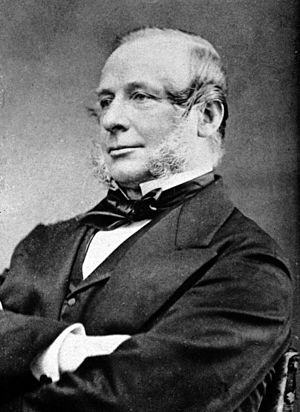Francis Sibson facts for kids
Francis Sibson (born May 21, 1814 – died September 7, 1876) was an English doctor and a scientist who studied the human body. He was known for his work on how our internal organs, especially our lungs, work when they are healthy and when they are sick. He was also a Fellow of the Royal Society, which is a very important group for scientists.
Early Life and Education
Francis Sibson was born in a place called Crosscanonby, near Maryport, in Cumberland, England. But he grew up and went to school in Edinburgh, Scotland.
When he was young, he became an apprentice to John Lizars. An apprentice is like a student who learns a skill or job from an expert. Lizars was a surgeon and an anatomist, which means he studied the structure of the human body. Francis Sibson learned a lot from him and got his first medical diploma in 1831.
During 1831 and 1832, there was a serious sickness called cholera. Francis Sibson helped treat many patients who had this disease.
He continued his studies at famous hospitals in London, like Guy's and St Thomas's Hospital. In 1835, he became a qualified apothecary, which was a type of pharmacist and doctor. After that, he worked as a surgeon and apothecary at the Nottingham General Hospital.
Later, in 1848, he went back to London and earned two important medical degrees, MB and MD. The next year, in 1849, he was chosen to be a Fellow of the Royal Society. This was a big honor for him.
Medical Career
In 1851, Francis Sibson became a doctor at St Mary's Hospital and also taught at its medical school. He was very interested in showing how the human body's internal organs looked when they were healthy and when they were affected by sickness. He especially focused on the lungs and breathing organs, studying their physiology (how they work) and pathology (how diseases affect them).
He held important leadership roles in the medical world:
- In 1862, he became the president of the Medical Society of London.
- From 1866 to 1869, he was the president of the British Medical Association Council. Later, he became a vice-president for life.
Francis Sibson also gave several special lectures at the Royal College of Physicians. These included the Goulstonian Lecture in 1854, the Croonian Lecture in 1870, and the Lumleian Lectures in 1874. These lectures are a way for important doctors to share their knowledge with others.
Personal Life and Legacy
In 1858, Francis Sibson married Sarah Mary Ouvry.
He is remembered in medicine because a part of the body is named after him. The Suprapleural membrane, which is a tissue near the top of the lungs, is also known as "Sibson's fascia."
Death
Francis Sibson died suddenly while he was on holiday in Geneva, Switzerland. He passed away at the Hôtel des Bergues on September 7, 1876.


